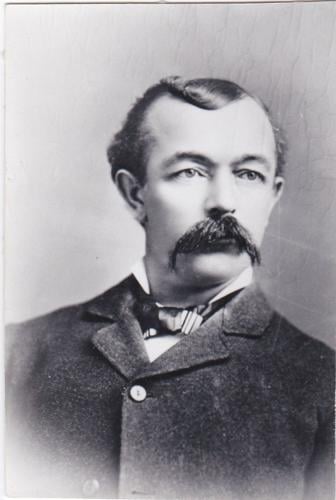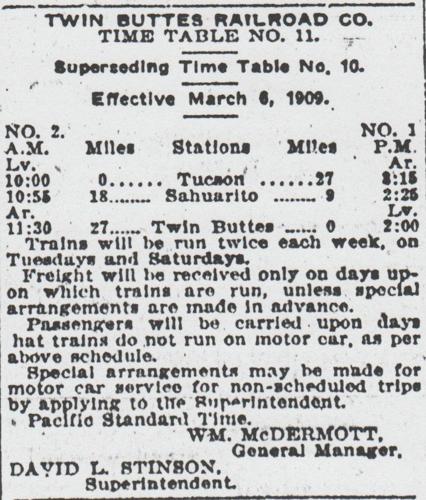Editor’s note: This article was originally published by the Star in 2016. We’re reprinting it because writer David Leighton recently talked about it on Arizona Spotlight on Arizona Public Media 89.1 radio and we remembered it’s a good read.
The name of a fast-growing Southern Arizona town may be a long-held misspelling.
In September 1820 — a year before Mexico won its independence — Tomas and Ignacio Ortiz, residents of Tubac, petitioned the governor of Sonora and Sinaloa for a land grant of four sitios (more than 27 square miles) of grassland around La Canoa to raise horses and cattle.
Conforming to Spanish law, the land had to be measured, appraised and auctioned before title could be granted. In July 1821, Ignacio Elias Gonzales, commander of the military post of Tubac, appointed officers and ordered the survey done. His account related to the survey of the San Ignacio de la Canoa land grant describes a vast domain that stretched from Tubac to the south to “el Saguarito, where there exists a plant of this tree, which remains as a landmark … ” to the north.
Because Mexico was undergoing its separation from Spain, no title was issued to the Ortiz brothers at that time. They finally got it in 1849.
The first known person to settle at “el Saguarito,” Spanish for the little saguaro, was Cyrus S. Rice, who was born in Maine in 1832 and traveled to California, possibly for the gold rush. In December 1861, he enlisted in Company I, 5th Infantry Regiment of the California Volunteers as a corporal, at Marysville, California, and served until he was discharged in 1864, in Las Cruces, New Mexico Territory.
Around 1867, Rice settled at “el Saguarito” along the Santa Cruz River. His new home was called the Sahuarita Ranch, which was likely a corruption of the original Spanish name for the area. On Dec. 23, 1868, he sold the ranch for $600 to Albert C. Benedict. The deed of sale describes the boundaries as, “Commencing at the Sahuara in front of and West from the house … ”
Instead of using a normal land deed (aka general warranty deed), Rice used a quit claim deed to sell his ranch. This type of deed can indicate the seller is unsure whether he owns the property, so Rice may have settled near the little saguaro or landmark without purchasing the land from a previous owner. Whichever is the case, Rice likely was the first to live here and is therefore the founder of what is now known as the town of Sahuarita.
Benedict, who was born around 1830 in Michigan and arrived in Arizona around 1860, married Gregoria Alvares just prior to his purchase of the Sahuarita Ranch. His Spanish-speaking wife might have pointed out the misspelling of the ranch name, because it was changed to the Sahuarito Ranch.
John Spring, who was stationed at Camp Lowell, would write years later about a stop on his trip from Tucson to Santa Cruz, Sonora. “At nightfall we stopped at a place called Sahuarito (little giant cactus), for an isolated plant of that kind growing near the place, which was an eating and watering station kept by one Benedict, about twenty-five miles south of Tucson and one mile west of the Santa Cruz River.”
In July 1872, Benedict and two ranch hands were in the field about 300 yards from the ranch house, planting beans and pulling up weeds, when Apaches attacked. Benedict took several bullets, including one to his foot that plagued him for life. That November, he was elected treasurer of Pima County, and later served as territorial auditor. In January 1874, Benedict began caring for horses and mules at the Sahuarito Ranch, charging $2.50 per animal per month with an unlimited quantity of grass (grain was available for an extra fee). The following year, he advertised the Sahuarito Ranch for sale in the Arizona Citizen newspaper, but apparently didn’t find a buyer.
By 1877, he had abandoned the Sahuarito Ranch and moved to the Huababi Ranch, on the Santa Cruz River south of Calabasas.
Sometime between April and November 1877, James K. “Jim” Brown and Tom Roddick obtained the Sahuarito Ranch from Benedict. In June 1879, Roddick was preparing to go to Texas to obtain cattle for the Sahuarito Ranch when he died suddenly. A couple of years later the ranch legally became the sole property of Brown.
In December 1879, Brown returned to his home state of Ohio and brought back a bride, Olive S. Brown. When she arrived at her new home, Olive found an eight-room ranch house with adobe walls and high ceilings. The front two living rooms had floors, while the rest of the house had hard-packed dirt floors. This structure was surrounded by a tall, thick, adobe wall.
On Sept. 4, 1882, the Sahuarito post office was established, with Brown as the postmaster and Olive as the assistant. It was used until June 11, 1886. Brown served as Pima County sheriff from 1891 to 1892.
Early in the new century, when the Twin Buttes Railroad was being built from Tucson to the mining camp called Twin Buttes, Brown granted the railroad right of way through his property with the agreement that the train station be called Sahuarito. A few years later, he sold off his ranch and holdings and moved to Tucson.
According to Olive S. Brand, granddaughter of James K. Brown, the family ranch was always known as the Sahuarito Ranch, not the Sahuarita Ranch.
On Oct. 11, 1915, the post office was reestablished as Sahuarita with T.G. Dumont as its postmaster. In time, the train station became known as Sahuarita as well.
As the town grew, it maintained the name Sahuarita, which it still has.
The new Sahuarita Branch of the Pima County Public Library opened at 670 W. Sahuarita Road in Sahuarita on September 7, 2021. The library features a storytime room, reading patios, private study rooms and a large meeting room for programming. Video by: Mamta Popat / Arizona Daily Star















